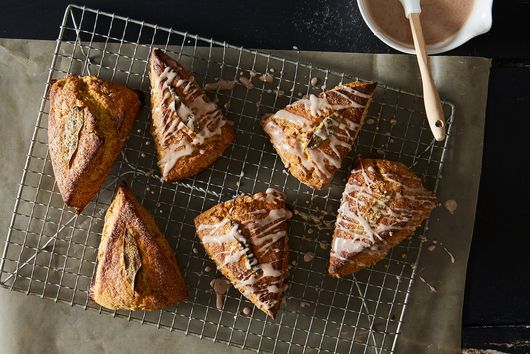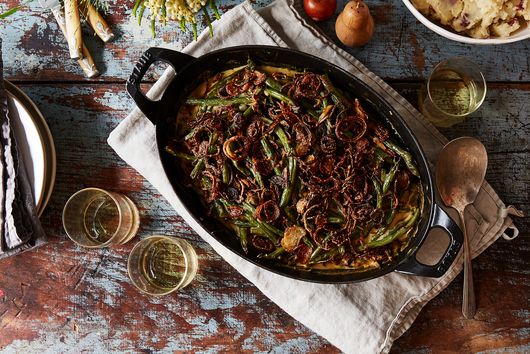Butternut Sage Scones
★★★★★
SERVES
8
Ingredients
2 cups
(about 9 oz. or 255 grams) all-purpose unbleached flour (I use King Arthur)
6 tablespoons
granulated sugar, plus more for sprinkling on top of scones
1 tablespoon
baking powder
1/2 teaspoon
kosher salt
1/2 teaspoon
ground cinnamon
1/2 teaspoon
fresh ground nutmeg
2 teaspoons
finely chopped fresh sage (optional)
6 tablespoons
cold unsalted butter, cut into small cubes
1/2 cup
butternut squash puree (see below for directions)
1/3 cup
heavy cream, plus more for brushing on top of scones
1
large egg
8
small sage leaves
Instructions
- When measuring flour, fluff with a whisk, scoop it up with a spoon, sprinkle it into the measuring cup, and sweep off the top with the flat edge of a knife or spatula. But when I make scones, I always weigh flour, and bypass all that extra work.
- FOR THE BUTTERNUT SQUASH: Pierce a medium butternut squash all over with a fork or tip of a knife. Place on microwave-safe dish and cook on high for about ½ hour, turning every ten minutes or so, until soft and mushy. Cut squash down the middle. If it’s still hard in the middle, nuke it a little more. Scoop out seeds and pulp. Scoop out the soft squash, mash it a bit, and place in a mesh strainer over a bowl. Let drain for a couple hours, or overnight. Depending on the size of your butternut, you’ll probably have extra squash, as this recipe only uses ½ cup. Make soup with the rest. Or double the scone recipe. And make a little less soup.
- FOR THE CINNAMON DRIZZLE: mix 1 cup confectioner’s sugar with ½ teaspoon cinnamon. Add 2 tablespoons warm water. Stir until smooth. I always do this by sight, so if too loose, add more sugar. If too thick, add more water. If not cinnamon-y enough, add more cinnamon. It should be thick like corn syrup. Set aside.
- In the bowl of a food processor fitted with the chopping blade, place the dry ingredients and the chopped sage, and pulse to combine.
- Add the butter, and pulse about 10 or so times. You want to retain some small pieces of butter. Don’t blitz the heck out of it. Transfer the flour mixture to a large mixing bowl. If you've got some really large butter lumps, just squish them with the back of a fork.
- In a large measuring cup, place the squash, egg and heavy cream. Mix well. Pour into flour mixture. With a dinner fork, fold the wet into the dry as you gradually turn the bowl. It’s a folding motion you’re shooting for, not a stirring motion. When dough begins to gather, use a plastic bowl scraper to gently knead the dough into a ball shape.
- Transfer the dough ball to a floured board. Gently pat into a 6” circle. With a pastry scraper or large chef’s knife, cut into 8 triangles. I use a pie marker to score the top of the dough circle and use the lines as a guide.
- OPTIONAL BUT RECOMMENDED: Place the scones on a wax paper-lined sheet pan and freeze until solid. Once they are frozen, you can store them in a plastic freezer bag for several weeks.
- Preheat oven to 425 degrees F. Place frozen scones on a parchment-lined sheet pan, about 1 inch apart. Brush with cream. Take the whole sage leaves, brush front and back with cream and place on tops of scones. Sprinkle tops of scones with sugar.
- Bake for about 20 - 25 minutes, turning pan halfway through. They are done when a wooden skewer comes out clean. When cool, drizzle with cinnamon glaze.
- Slather with clotted cream and fig jam, if you feel like gilding the lily. But if not, these are pretty darn good with just plain ol’ butter, too. These are great the next day, warmed in the microwave for 15 - 20 seconds. They freeze really well, too, and can be reheated in a 350 degree F oven until warm. Enjoy!
- BAKING TIPS: Last but not least, I highly recommend you get an oven thermometer, if you don't have one already. The success of quick breads like this depend upon a really cranking hot oven, and if your oven fluctuates, like mine does, then you can adjust your oven temp accordingly. Mine always runs cooler, so I crank it up until the thermometer reads the temp I want. Also, if you are baking less than a full batch, double up on your baking sheets, which helps prevent scorched bottoms.





